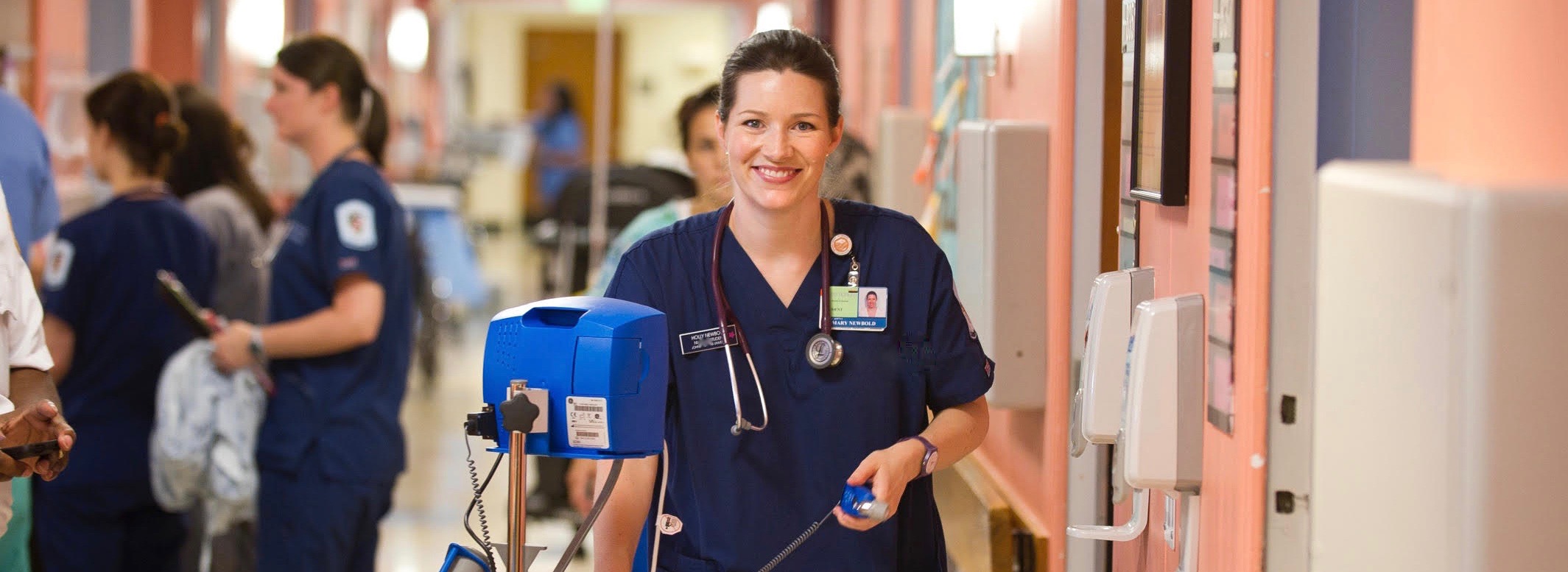Right in the thick of DNAP, even 200 miles away
The professor at the front of the classroom called on Holly Newbold.
She jumped into the conversation. It doesn’t matter that she’s in Roanoke, Va., more than three hours away by car. Even though she was miles from that classroom, Newbold was as part of that discussion as any other nurse anesthesia student in the same room as the educator. Being able to pursue her CRNA and DNAP without leaving her hometown was attractive, and VCU’s top ranking, as she adds, was “the cherry on top.”
“VCU does distance learning better than anyone else,” says Newbold, who built a successful real estate business in Roanoke before deciding to enter nursing and then nurse anesthesia. “Unlike a lot of other universities, VCU does an incredible job of making distance learning students feel included and that we are equal shareholders. All of the professors know our names. They call on us like anyone else in the room."
Through the distance learning channel, the nurse anesthesia program offers state-of-the-art instruction to students in the Roanoke, Abingdon and Northern Virginia regions. While its professors in Richmond primarily deliver live classroom components using in-room cameras and monitors installed at each site, the program also carefully vets local practitioners to aid in hands-on clinical training in those distant regions. The clinical sites follow protocols to give distance students a variety of surgical experiences, and VCU reviews regularly scheduled student feedback to ensure future nurse anesthetists are getting the same high-caliber surgical experiences as their Richmond peers.
VCU faculty travel regularly to each site to provide specialized hands-on workshops and support. Students also have the opportunity to complete rotations both locally and at a range of elective surgical settings throughout Virginia and beyond. Distance students also come to VCU Health to attend on-campus seminars, guest lectures and other events. Indeed, Newbold gushes slightly as she recalls attending a session that introduced the flexible fiberoptic bronchoscope, in which students got to visualize their own vocal cords.
Newbold arrived at nurse anesthesia in a round-about way. She first established that career in real estate, working as an appraiser before she partnered with her mother to buy and flip houses. She still owns a handful of rental properties, many rented to medical residents and other health-care providers working at Roanoke’s Carilion campus.
When her grandmother, who had been in relatively good health, faced a sudden health challenge, Newbold spent a lot of time with her in the hospital and rehabilitation center. She fell in love with the nurses who cared for her grandmother, and her sister –a nurse since 2008, who is now studying to become a nurse practitioner – encouraged her to pursue the field. Newbold went to Johns Hopkins University and completed her nursing degree in 2012.
As she considered where she would find a long-term role in the profession, Newbold shadowed nurses in every area of practice. She found herself repeatedly drawn to nurse anesthetists.
“They were by far the happiest. They felt autonomous, independent, and empowered,” says Newbold, who applied to VCU after working for four years as a nurse. “They felt the most fulfilled by the work they were doing. They felt they could make decisions in the surgical setting that benefited the patients. The scope of their practice is broader.”
At the same time, VCU’s program supports adult learners and “chooses students who will rise to the occasion,” Newbold says. “There are extremely high expectations for nurse anesthetists.”
The program’s commitment to making patient safety real reinforces those expectations, and she recognizes that nurse anesthetists have critical roles beyond simply managing effective anesthesia.
“It means having the strength of character and the willingness to do the uncomfortable thing, particularly because anesthetized patients cannot speak for themselves. It’s our job to advocate for our patients and to protect them from the rigors of surgery or from a poor judgment call,” she says. “It’s our responsibility to stay up-to-date on what the evidence and research tell us today – and what they will tell us 10 years from now.”
- Learn more about VCU Nurse Anesthesia's distance learning and DNAP entry to practice programs.
